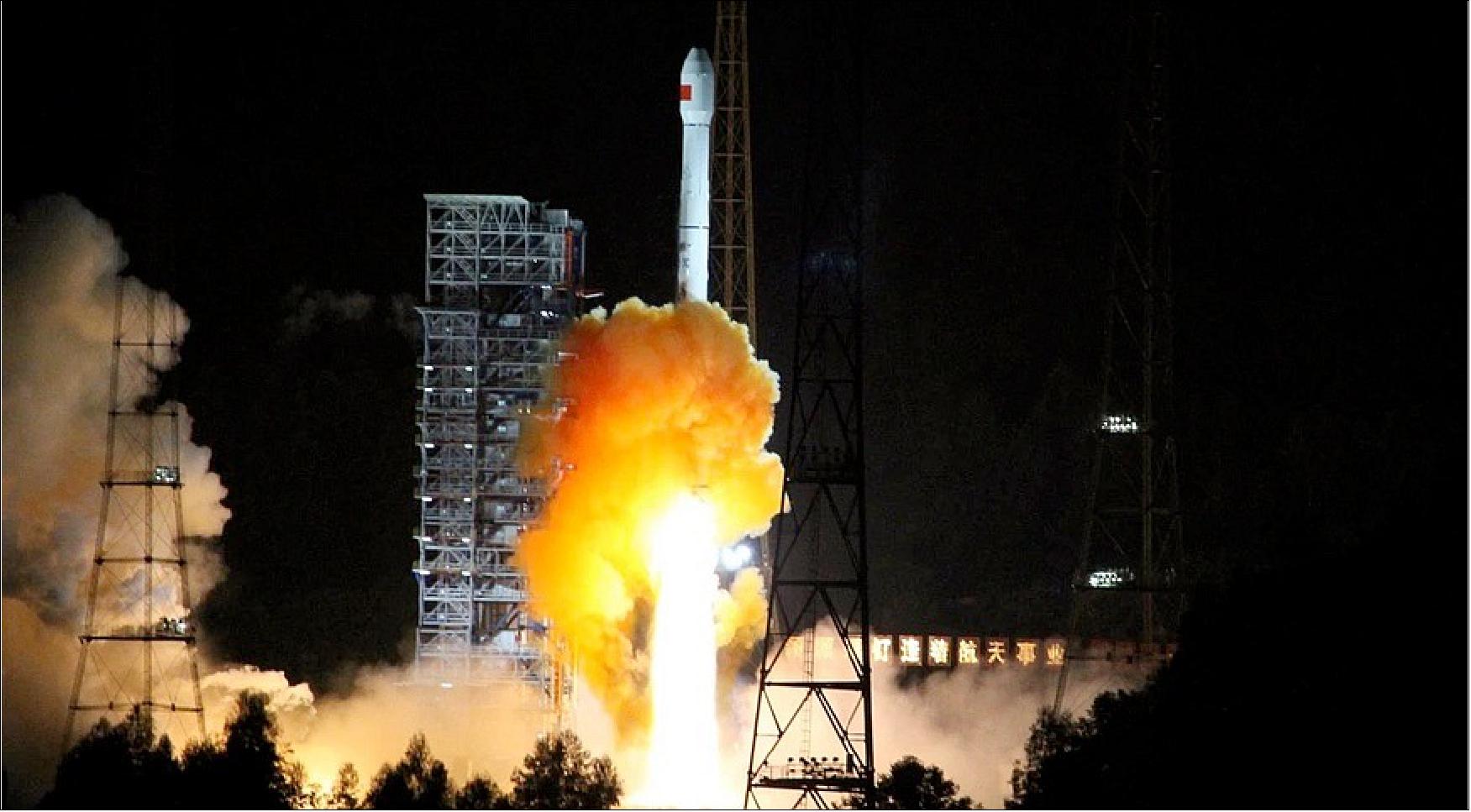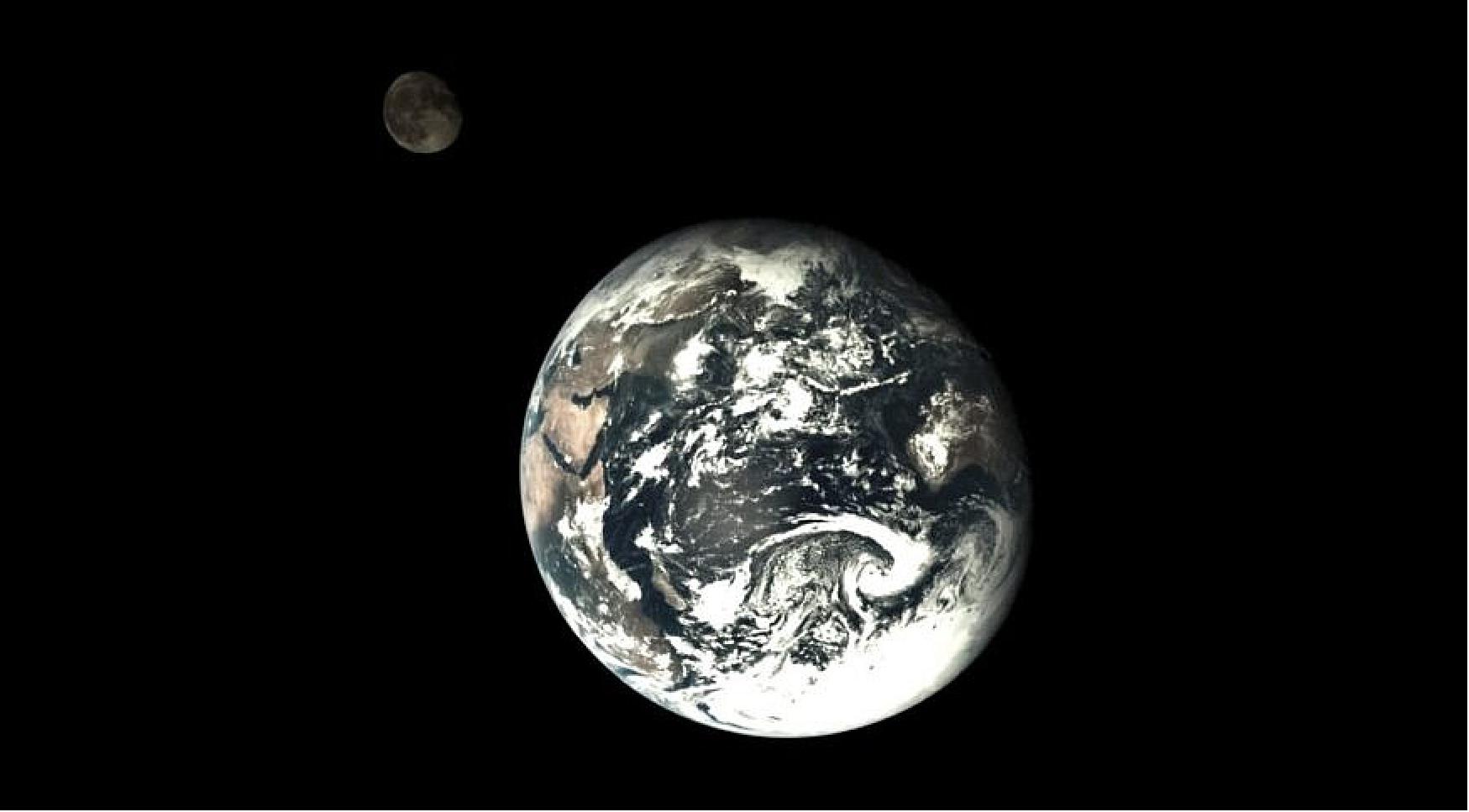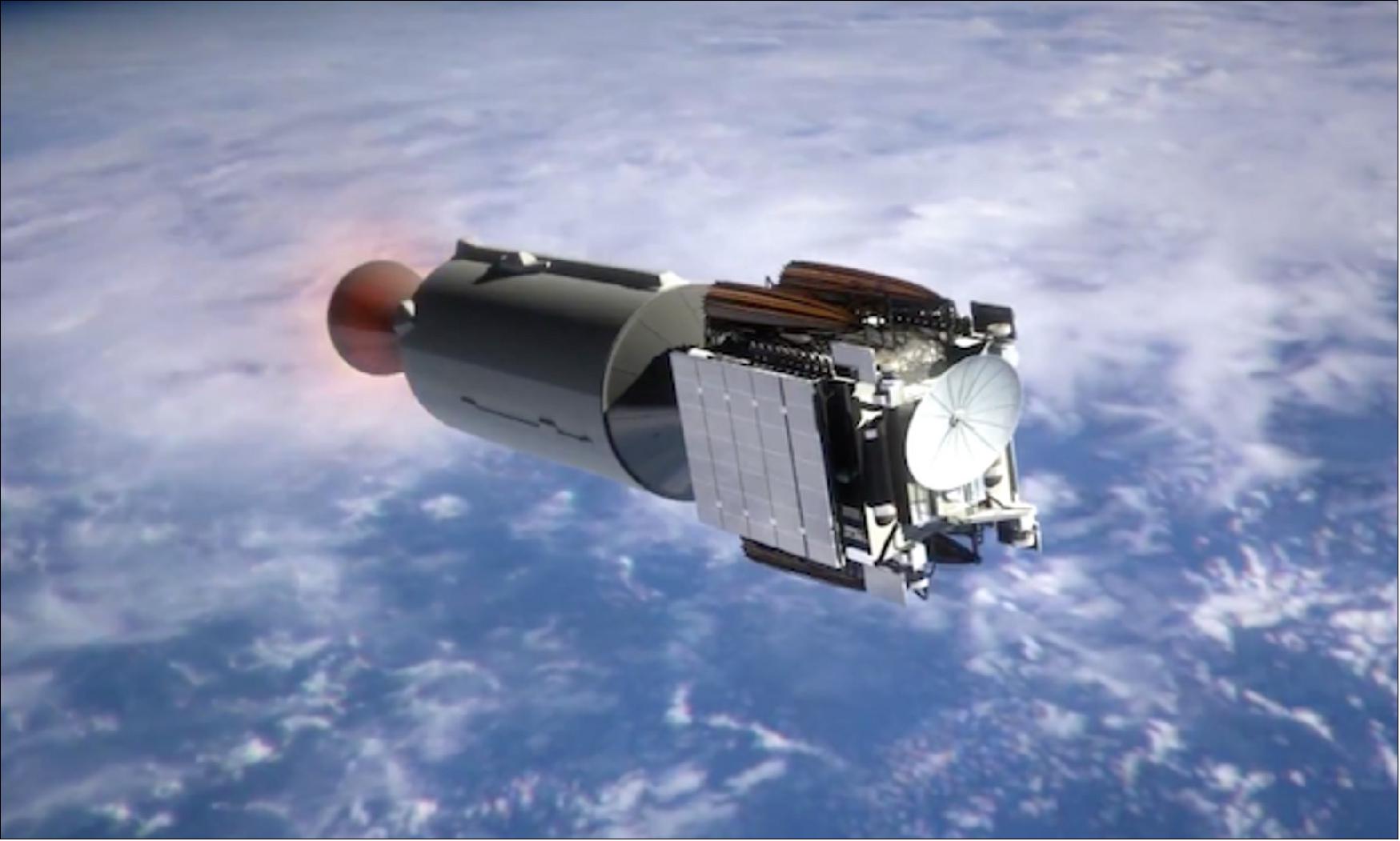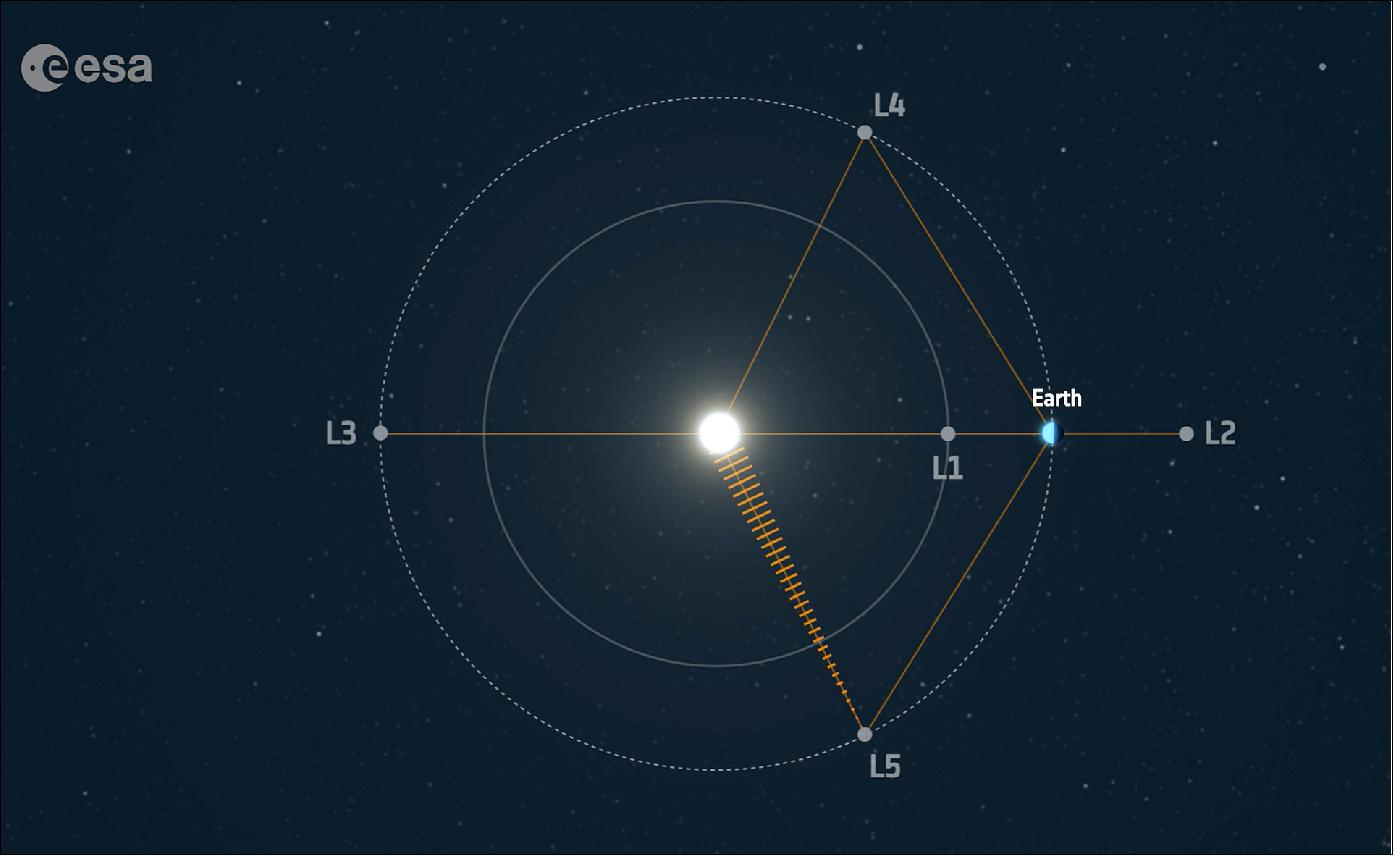Moon: Debris impact
People and News
Incoming! Debris Enroute to the Moon
• February 13, 2022: In a case of celestial mistaken identity, a spent upper stage that will crash on the far side of the moon in March is now linked to a Chinese launch in 2014, not a SpaceX launch of an Earth and space science satellite in 2015, illustrating the difficulties in tracking objects beyond Earth orbit. 1)
- Astronomer Bill Gray reported Jan. 21 that an object designated WE0913A was on a trajectory that would collide with the moon March 4. Gray had previously identified WE0913A as the upper stage from the February 2015 Falcon 9 launch of the Deep Space Climate Observatory (DSCOVR), a spacecraft launched to the Earth-sun L-1 Lagrange point to monitor solar activity and provide full-disk images of the Earth. The stage was left in a chaotic orbit in cislunar space.

- The upcoming collision attracted worldwide attention and, in some cases, criticism of SpaceX for “littering” the moon. The object is expected to crash near the crater Hertzsprung on the lunar farside, far from any other spacecraft landing sites, and create a crater about 20 meters across.
- Gray, though, revised the identification of WE0913A Feb. 12. He said he linked the object to the Falcon 9 upper stage back in 2015 on the assumption that the stage passed close to the moon shortly after launch. However, he said he was informed DSCOVR itself did not pass close to the moon on its way to L-1, thus it was unlikely that the upper stage made that close flyby.
- A better fit to observations of WE0913A, he said, was the launch of China’s Chang’e-5 T1 spacecraft on a Long March 3C in October 2014. That spacecraft flew a free-return trajectory around the moon to test the ability of a sample return capsule to survive reentry and land on Earth. That stage flew close to the moon several days after launch on an orbit that matches what’s expected of a stage that launched a spacecraft on a translunar trajectory.
- “In a sense, this remains ‘circumstantial’ evidence. But I would regard it as fairly convincing evidence,” Gray wrote. “So I am persuaded that the object about to hit the moon on 2022 Mar 4 at 12:25 UTC is actually the Chang’e 5-T1 rocket stage.”
- The series of events shows the difficulty in tracking objects in cislunar space, given the lack of telescopes, radars or other tools to identify them. The Defense Department has shown a growing interest in monitoring activities in cislunar space, sometimes called xGEO, out of concerns that rival powers could hide anti-satellite weapons there. The Air Force Research Lab (AFRL) is pursuing a mission called Cislunar Highway Patrol System to test space domain awareness technologies in cislunar space.
- “As we push further away, there are going to be challenges when we push into xGEO and cislunar from a sustainability aspect,” said Andrew Williams, deputy technology executive officer for space S&T at AFRL, during a panel discussion at the SmallSat Symposium Feb. 9. That includes, he said, what’s considered a proper disposal orbit for stages like the one that will hit the moon. “There’s a lot of extra dynamics to the sustainability challenge.”
- That will become a larger issue as robotic and human activity on and around the moon increases in the next decade. The upcoming impact “illustrates well the need for a comprehensive regulatory regime in space, not only for the economically crucial orbits around Earth but also applying to the moon,” said Holger Krag, head of ESA’s Space Safety Program, in a Feb. 2 statement.
Events and Developments
• February 23, 2022: A rocket stage expected to impact the moon is still most likely to belong to China’s 2014 moon mission, despite a denial from the country’s Ministry of Foreign Affairs. 2)
- The response from a Chinese foreign ministry spokesperson may have confused the mission in question, apparently referring to the 2020 “Chang’e-5 mission,” instead of the 2014 mission, Chang’e-5 T1.
- The second stage of the Long March 5 rocket which launched the 2020 Chang’e-5 mission reentered the atmosphere over the Pacific Ocean a week after launch. The fate of the rocket upper stage from the 2014 mission is murkier.
- Space tracking data from the U.S. Space Force’s 18th Space Control Squadron (18SPCS) suggests the upper stage (international designator 2014-065B) of the Long March 3C rocket which launched Chang’e-5 T1 reentered the atmosphere in 2015, apparently backing China’s denial.
- However the reported orbital decay of the object may instead be an extrapolation of a single trajectory data point soon after launch, and therefore not reliable.
- Bill Gray, the astronomer who first noted that a rocket stage was due to impact the moon back in January, believes this may be the case. If the reentry date is a prediction a year ahead of time then it that would be like trying to predict weather a year ahead of time, says Gray.
- “It could be that 18SPCS did track it [2014-065B] over the following year. But if they had, they probably would have posted an updated trajectory publicly. They’re usually quite reliable about that,” Gray said in an updated post following Monday’s Foreign Ministry comment.
- 18SPCS did not respond to a request for comment by press time. Neither the China National Space Administration (CNSA) nor the State Administration for Science, Technology and Industry for National Defense (SASTIND) responded to emails from SpaceNews requesting clarification.
- U.S. Space Force tracking is focused on lower orbits, relying mainly on radar for tracking data. Asteroid observers, using optical telescopes, are however understood to have tracked the object several times since, allowing Gray to state that the object would hit the moon in March.

- The European Space Agency’s European Space Operations Centre (ESOC), which also has its own tracking capabilities and space object database, does not list the 2,800-kilogram rocket stage 2014-065B as having reentered the atmosphere. Once again however, ESA tracking focuses on low, medium and geosynchronous orbits.
- CNSA established its Space Debris Monitoring and Application Center in 2015, at the National Astronomical Observatory of the Chinese Academy of Sciences, but does not keep a public space object database.
- Gray, who runs the Project Pluto webpages and related software, is one of few who track deep space debris.
- Independent spectral analysis by students at the University of Arizona also adds to the evidence that the object’s identity most likely belongs to China’s Chang’e-5 T1 mission.
- “We took a spectrum and compared it with Chinese and SpaceX rockets of similar types, and it matches the Chinese rocket,” said associate professor Vishnu Reddy, who co-leads the University of Arizona’s Space Domain Awareness lab. “This is the best match, and we have the best possible evidence at this point.”
- The interest in the object began in January when Bill Gray reported that a space object previously discovered by the Catalina Sky Survey and given the temporary name WE0913A was not a rock but likely a rocket stage and would impact the moon on March 4.
- It was initially thought to be a second stage from the February 2015 SpaceX Falcon 9 launch of the DSCOVR climate observatory, but then found to be more likely a fit with 2014-065B from China’s Chang’e-5 T1 mission.
- This led to the denial from China. “According to China’s monitoring, the upper stage of the rocket related to the Chang’e-5 mission entered into Earth’s atmosphere and completely burned up,” Foreign Ministry spokesperson Wang Wenbin said Feb. 21, in response to a question from the Associated Press, which specified the “lunar mission launched from China in 2014.”
- The Chang’e-5 mission, apparently referenced by Wang, launched in November 2020, collecting 1.7 kilograms of fresh lunar samples from the moon and delivering them to Earth in December 2020.
- Chang’e-5 T1 was a 2014 trial mission for the more ambitious Chang’e-5 lunar sample-return mission. It successfully tested a high-velocity spacecraft “skip reentry” after returning from the moon, verifying a reentry capsule could safely deliver lunar rocks to Earth.
- The rocket upper stage which inserted Chang’e-5 T1 into lunar transfer orbit has apparently been in a chaotic orbit, transferring between the Earth and moon, ever since.
- The Long March 3C rocket upper stage also carried the Manfred Memorial Moon Mission (4M) for Luxembourg. The 14-kilogram payload was designed to transmit signals during its journey to the moon. It is thought to be no longer active.
- The issue is expected to become more important in coming years as both the United States and a number of partners and China and Russia are planning respective Artemis and International Lunar Research Station (ILRS) programs to establish a long term presence on the moon.
- “The upcoming lunar impact illustrates well the need for a comprehensive regulatory regime in space, not only for the economically crucial orbits around Earth but also applying to the Moon,” Holger Krag, Head of ESA’s Space Safety Programme, said in a recent ESA release.
• February 2, 2022: The Moon is set to gain one more crater. A leftover SpaceX Falcon 9 upper stage will impact the lunar surface in early March, marking the first time that a human-made debris item unintentionally reaches our natural satellite. 3)
In 2015 the Falcon 9 placed NOAA’s DSCOVR climate observatory around the L1 Lagrange point, one of five such gravitationally-stable points between Earth and the Sun. Having reached L1, around 1.5 million km from Earth, the mission’s upper stage ended up pointed away from Earth into interplanetary space.

This rendered a deorbit burn to dispose of it in our planet’s atmosphere impractical, while the upper stage also lacked sufficient velocity to escape the Earth-Moon system. Instead it was left in a chaotic Sun-orbiting orbit near the two bodies.
Now credible public estimates forecast its impact with the Moon on 4 March at 12:25:39 UTC at a point on the lunar far side near the equator. Follow-up observations should sharpen the accuracy of the forecast, but the approximately 3 ton, 15 m long by 3 m wide upper stage is currently projected to hit at a speed about 2.58 km/s.

Scientifically Vital Points in Space
The European Ariane 5 that recently delivered the James Webb Space Telescope to its observing point flew a mirror trajectory to that of the Falcon 9 – but the good news is that its upper stage has already evaded a comparable fate thanks to a specifically developed and qualified maneuver.
Europe’s Ariane 5 delivered the James Webb Space Telescope to L2, the second Sun-Earth Lagrange point – ‘behind’ instead of in ‘front of’ our planet – but after separating from Webb the upper stage used all its remaining fuel to escape the Earth-Moon system entirely, putting it into a stable heliocentric orbit.
History of Human-Made Moon Impacts
Human-made objects have intentionally impacted the Moon before, starting as early as the 1950s, including Apollo upper stages used to induce ‘moonquakes’ for surface seismometers.
In 2009 NASA crashed its LCROSS mission into the Moon, revealing water in the resulting debris plume, with the LADEE spacecraft doing the same on the lunar farside in 2013. ESA’s Smart-1 spacecraft was crashed into the Moon in 2006, the subject of a worldwide observing campaign.


“This forthcoming Falcon 9 impact is a little beyond our usual area of interest, because we are mainly focused on the debris population in highly-trafficked low-Earth orbits, up to 2000 km altitude, as well as geosynchronous orbits around 35,800 km away,” explains Tim Flohrer of ESA’s Space Debris Office.
“Our colleagues in the ESA Planetary Defence Office peer further into space, however. They use telescopes around the globe to track Near-Earth asteroids, and sometimes observe human-made objects as well. Extending our own remit into the ‘cislunar’ space between Earth and the Moon has been discussed, due to the increasing use of the scientifically vital Sun-Earth Lagrange points in coming years.”
Detlef Koschny, heading ESA’s Planetary Defence Office, adds: “We use telescopic observations to pinpoint the orbits, mainly of natural objects in the space surrounding Earth. Occasionally, we also pick up man-made objects far away from the Earth, such as lunar exploration spacecraft remnants, and objects returning from Lagrange points.”

For international spacefarers, no clear guidelines exist at the moment to regulate the disposal at end of life for spacecraft or spent upper stages sent to Lagrange points. Potentially crashing into the Moon or returning and burning up in Earth’s atmosphere have so far been the most straightforward default options.
“The upcoming Falcon 9 lunar impact illustrates well the need for a comprehensive regulatory regime in space, not only for the economically crucial orbits around Earth but also applying to the Moon,” says Holger Krag, Head of ESA’s Space Safety Programme.
“It would take international consensus to establish effective regulations, but Europe can certainly lead the way.”
All the launchers developed by ESA during the last decade – Vega, Ariane 6 and Vega C – incorporate a built-in reignition capability, which ensures the safe return to Earth for atmospheric burn-up of their upper stages.
Assessing Lunar Impact Risk
Space rocks hit the Moon all the time. Researchers are interested in quantifying the frequency of these natural lunar impacts. Using a system developed through an ESA contract, the Greek NELIOTA project (Near-Earth object Lunar Impacts and Optical TrAnsients) detects flashes of light caused by small bodies striking the Moon’s surface, particularly across its shadowed face. NELIOTA can determine the temperature of these impact flashes as well as their brightness. From this, the impacting mass can be estimated.

ESA’s Space Safety programme is interested in this research as a way of assessing the number of incoming objects ranging in size from tens of centimetres to metres across. This is useful because the precise number of objects in this range is not known very well.
This research might also be valuable for future lunar colonists. One of the dangers they might face is small meteoroids doing damage to their infrastructure – NELIOTA results are helping to quantify the danger. Without an atmosphere to burn up such bodies, it is likely that future permanent lunar structures will be underground, to provide shielding against impacts as well as space radiation.

References
1) Jeff Foust,”Chinese rocket, not Falcon 9, linked to upper stage on lunar impact trajectory,” SpaceNews, 13 February 2022, URL: https://spacenews.com/
chinese-rocket-not-falcon-9-linked-to-upper-stage-on-lunar-impact-trajectory/
2) Andrew Jones, ”Moon-bound rocket stage still most likely from 2014 Chang’e mission, despite China’s denial,” SpaceNews, 23 February 2022, URL: https://spacenews.com/moon-bound-rocket-stage-still-most-likely-from-2014-change-mission-despite-chinas-denial/
3) ”Incoming! Debris enroute to the Moon,” ESA Safety & Security, 2 February 2022, URL: https://www.esa.int/Safety_Security/Space_Debris/Incoming!_Debris_enroute_to_the_Moon
The information compiled and edited in this article was provided by Herbert J. Kramer from his documentation of: ”Observation of the Earth and Its Environment: Survey of Missions and Sensors” (Springer Verlag) as well as many other sources after the publication of the 4th edition in 2002. - Comments and corrections to this article are always welcome for further updates (eoportal@symbios.space).